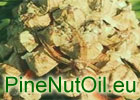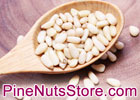PINE NUTS - A TREASURE-HOUSE OF USEFUL SUBSTANCES
PineNutOil.org
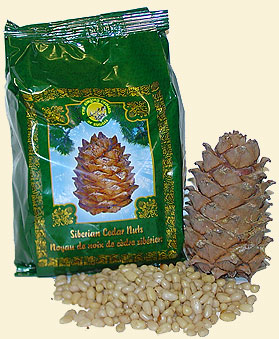 The nutritional and medicinal properties of nuts come largely from their content of fat, protein and other substances. Cedar nut fat differs from other fat sources in its high content of polyunsaturate fatty acids, especially linolic acid.
The nutritional and medicinal properties of nuts come largely from their content of fat, protein and other substances. Cedar nut fat differs from other fat sources in its high content of polyunsaturate fatty acids, especially linolic acid.
First among nitrogenous substances are the proteins, which in turn are characterised by an elevated content of amino acids, especially arginine. These amino acids are extremely important to development of the growing organism. Hence Pine Nuts have been essential in the diet of children, teenagers and pregnant women. Nut protein is easy to digest.
Pine Nuts contain valuable lipolytic vitamins E and P . E-group vitamins, or tocopherols, are very important and essential in ensuring complete genetic heredity. (The word tocopherol in Greek literally means "I bear offspring".) A deficiency of Vitamin E upsets the fatty balance in the system. Vitamin E is responsible for the production of milk in nursing mothers, and its deficiency can stop lactation. A person's predisposition to atherosclerosis can also be explained by a Vitamin-E deficiency.
Pine Nuts contain a complex of B vitamins, which normalise the activity of the nervous system, have a favourable influence on the growth and development of the human organism, and improve blood composition. Young wolves delight in feasting on Pine Nuts during exfoliation. Pine Nuts are used by both carnivores and herbivores, and are an effective antidote to vitamin deficiency, which causes serious disorders in the system.
Cedar nut nuclei are rich in valuable mineral substances and micronutrients. The food value is confirmed by the chemical composition of the Pine Nuts. They surpass all other nuts as well as oil seeds in terms of phosphatidic content. As the richest source of lecithin they are comparable only to soybean. Pine Nuts are also a rich source of iodine, which is very important to residents of northern latitudes.
Pine Nuts offer a suffieint daily intake to satisfy an adult organism's daily need for amino acids, as well as such important and often deficient micronutrients as copper, cobalt, manganese and zinc. On the whole Pine Nuts are very easy to digest, and have a tremendous beneficial effect on the human organism.
The shell of the cedar nut in pulverised form can be used as animal feed. It has an average food value in comparison with other types of feed. Granted, it does contain a good deal of fibre, making it more challenging to digest.
The process of extracting oil from the cedar nut by the cold-press method leaves a cedar oil powder which is rich in biologically active substances, micronutrients, proteins, Vitamins E, A, C, U of Group B, unsaturated fatty acids with no cholestorol content. This is an excellent dietary product, which facilitates the normalisation of substance metabolism, maintenance of health and preservation of human work capacity for many years. It can be added to desserts, creams, fruit and vegetable salads. It gives cakes, pies, ice cream and other confectionary products a delicate taste and aroma. It can be used as well with cottage cheese, honey, muesli, cereals etc.
COMPOSITION OF Pine Nuts
Nutrient Analysis Source: Custom
1 Yield: (28.000 gram(s))
No. Ingredients: 1
Category: Basic Food
Manufacturer: (None)
Nutrient Goal Template: DAILY VALUES/RDI - ADULT/CHILD
Percentage of Kcals
Protein 10.0%
Carbohydrate 6.2%
Fat, total 83.8%
Alcohol 0.0%
Table prepared by First DataBank Nutritionist Pro™ Nutrient Value Unit Goal %
| Nutrient | Value | Unit | Goal | % |
|---|---|---|---|---|
| Weight | 28.000 | g | ||
| Kilocalories | 186.760 | kcal | 2000.000 | 9 % |
| Protein | 1.904 | g | 50.000 | 4 % |
| Carbohydrate | 1.176 | g | 300.000 | 0 % |
| Fat, Total | 7.056 | g | 65.000 | 11 % |
| Alcohol | 0.000 | g | ||
| Cholesterol | 0.000 | mg | 300.000 | 0 % |
| Saturated Fat | 2.626 | g | 20.000 | 13 % |
| Monounsaturated Fat | 6.424 | g | ||
| Polyunsaturated Fat | 7.187 | g | ||
| MFA 18:1, Oleic | 6.028 | g | ||
| PFA 18:2, Linoleic | 6.967 | g | ||
| PFA 18:3, Linolenic | 0.220 | g | ||
| PFA 20:5, EPA | ||||
| PFA 22:6, DHA | ||||
| Trans Fatty Acid | ||||
| Sodium | 20.160 | mg | 2400.000 | 1 % |
| Potassium | 175.840 | mg | 3500.000 | 5 % |
| Vitamin A (RE) | 0.840 | RE | ||
| Vitamin A (IU) | 8.120 | IU | 5000.000 | 0 % |
| Vitamin A (RAE) | 0.280 | µg | ||
| Beta-Carotene | ||||
| Alpha-Carotene | ||||
| Lutein (+ Zeaxanthin) | ||||
| Beta-Cryptoxanthin | ||||
| Lycopene | ||||
| Vitamin C | 0.560 | mg | 60.000 | 1 % |
| Calcium | 2.240 | mg | 1000.000 | 0 % |
| Iron | 0.857 | mg | 18.000 | 5 % |
| Vitamin D (ug) | 0.000 | µg | 10.000 | 0 % |
| Vitamin D (IU) | 0.000 | IU | 400.000 | 0 % |
| Vitamin E (mg) | 20.000 | |||
| Vitamin E (IU) | 30.000 | |||
| Alpha-Tocopherol | ||||
| Thiamin | 0.348 | mg | 1.500 | 23 % |
| Riboflavin | 0.062 | mg | 1.700 | 4 % |
| Niacin | 1.224 | mg | 20.000 | 6 % |
| Pyridoxine (Vitamin B6) | 0.031 | mg | 2.000 | 2 % |
| Folate (Total) | 16.240 | µg | 400.000 | 4 % |
| Folate (DFE) | 16.240 | µg | ||
| Cobalamin (Vitamin B12) | 0.000 | µg | 6.000 | 0 % |
| Biotin | 300.000 | |||
| Pantothenic Acid | 0.059 | mg | 10.000 | 1 % |
| Vitamin K | 80.000 | |||
| Phosphorus | 9.800 | mg | 1000.000 | 1 % |
| Iodine | 150.000 | |||
| Magnesium | 65.520 | mg | 400.000 | 16 % |
| Zinc | 1.198 | mg | 15.000 | 8 % |
| Copper | 0.290 | mg | 2.000 | 14 % |
| Manganese | 1.213 | mg | 2.000 | 61 % |
| Selenium | 70.000 | |||
| Fluoride Chromium | 0.120 | |||
| Molybdenum | 75.000 | |||
| Dietary Fiber, Total | 2.996 | g | 25.000 | 12 % |
| Soluble Fiber | ||||
| Insoluble Fiber | ||||
| Crude Fiber | ||||
| Sugar, Total | ||||
| Glucose | ||||
| Galactose | 0.000 | g | ||
| Fructose | ||||
| Sucrose | ||||
| Lactose | 0.000 | g | ||
| Maltose | ||||
| Sugar Alcohol | ||||
| Other Carbohydrate | ||||
| Tryptophan | 40.880 | mg | ||
| Threonine | 102.760 | mg | ||
| Isoleucine | 126.000 | mg | ||
| Leucine | 233.520 | mg | ||
| Lysine | 121.520 | mg | ||
| Methionine | 57.960 | mg | ||
| Cystine | 58.800 | mg | ||
| Phenylalanine | 124.040 | mg | ||
| Tyrosine | 118.720 | mg | ||
| Valine | 167.440 | mg | ||
| Arginine | 630.280 | mg | ||
| Histidine | 77.560 | mg | ||
| Alanine | 169.400 | mg | ||
| Aspartic Acid | 295.120 | mg | ||
| Glutamic Acid | 551.320 | mg | ||
| Glycine | 164.920 | mg | ||
| Proline | 174.160 | mg | ||
| Serine | 137.480 | mg | ||
| Moisture | 1.652 | g | ||
| Ash | 0.633 | g | ||
| Caffeine | 0.000 | mg |
Friday, September 01, 2006 First DataBank Nutritionist Pro™
g = gram; mg = milligram; mcg = microgram; IU = International Units
According to research, the cedar nut nucleus weighs, on average, approximately 43% of the total mass of the nut. These amazing seeds contain, as has been stated above, an incredible number of useful substances: vitamins, micronutrients, proteins, carbohydrates and fats. Let us examine all this treasure in more detail.
Nut nuclei contain 63.9% high-quality oil and 17.2% easily digestible proteins, including 19 aminoacids:
- triptophane
- leucine and isoleucine
- amino isovaleric acid
- diamino-hexanoic acid
- methionine
- glutanic acid
- histidine
- pyrrolidine carboxylic acid
- serine
- aminoacetic acid
- threonine
- lactamic acid
- asparagic acid
- phenylalanine
- cystine and cysteine
- arginine
- tyrosin e
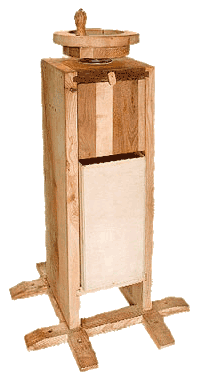 |
| Pine Nut Sheller |
70% of these are essential and relatively essential, which indicates the high biological value of proteins. While arginine (up to 21g/100 g of protein) is considered replaceable in the diet of an adult person, it is considered essential in the case of children.
Cedar nut protein is distinguished from the protein of other products by its elevated content of diamino-hexanoic acid (up to 12.4g/100g of protein), methionine (up to 5.6g/100g of protein) and triptophane (up to 3.4g/100g of protein) - these are the most frequently deficient amino acids, which usually limit the biological value of protein in product composition.
The vitamins contained in Pine Nuts contribute to the growth of the human organism. The composition of the nuts, therefore, includes the following vitamins:
- Vitamin A - the vitamin for growth and development;
- Vitamin B1 (thiamine) - which regulates the oxidation of carbohydrate metabolism products, and participates in the metabolism of amino acids, the formation of fatty acids and influences cardiovascular, digestive, glandular functions as well as the function of the central and peripheral nervous system;
- Vitamin B2 (riboflavin) - which helps the organism in the conversion of proteins, fats and carbohydrates into energy and is essential to the formation and sustenance of the fabric of the organism; it increases sensitivity of vision to light and colour, has a positive influence on the condition of the nervous system, skin and mucous membranes, the functioning of the liver and blood formation;
- Vitamin B3 (niacin) - which is important for fat synthesis, protein metabolism and food-energy conversion; it acts to regulate the higher nervous activity, the cardiovascular system, the functioning of the digestive organs, cholestorol metabolism and blood formation;
- Vitamin E (tocopherol), which influences the functions of the sex and other vascular glands, stimulates the action of the muscles, participates in the metabolism of proteins and carbohydrates, facilitates the digestion of fats, Vitamins A and O, and also protects cell membranes from injury.
Pine Nuts are rich in the most important macro- and micronutrients:
- copper - which is involved in the functioning of the brain and is essential for the formation of red corpuscles;
- magnesium - which is required for the formation of correct bone structure, and is also an important component of soft tissue;
- manganese - which is essential for the tendrons and hormones and helps the organism take in glucose; it also participates in the activity of the enzymes in the reproductive process, as well as growth and fat metabolism;
- silicon - which facilitates the formation and elasticity of the organism's connective tissue, and also participates in the calcification of the bones;
- vanadium - which retards the formation of cholestorol in the blood vessels; it also participates in the activity of the enzymes, in the metabolism of glucose and fat, and in the development of bones and teeth;
- potassium - which regulates the organism's water balance; it also assists in the normalisation of cardiac contractions and supplying nutrition to the muscle system;
- phosphorous - which is involved in the formation and maintenance of teeth and bones and plays an important role in the activity of the muscles and nerve cells and in quick energy release;
- calcium - which is the main component of bones and teeth and is essential for blood coagulation, cell integrity and heart action; it is also important for normal muscle contraction and the functioning of the nervous system;
- molybdenum - which assists in the metabolism of carbohydrates and fats, and facilities prevention of blood deficiency;
- nickel - a deficiency of which influences blood formation and retrads growth, along with changes in the content of iron, copper and zinc in the liver;
- iodine - which is part of the hormones of the thyroid gland and is essential for full metabolism processes;
- tin - a deficiency of which in the organism may lead to retardation of growth;
- boron - a deficiency of which can weaken mental alertness and the capacity to bear physical burdens;
- zinc - which plays a vital role in the restoration of tissue, normal skeletal growth and muscle contraction, and also helps in healing wounds and contributes to the normal functioning of the prostate gland;
- iron - which is the most important component in hemoglobin and protein.
Apart from the micronutrients listed above, Pine Nuts also contain barium, titanium, silver, aluminium, iodide, cobalt and sodium.
The composition of Pine Nuts includes carbohydrates such as:
- glucose
- fructose
- sucrose
- sugar
- starch
- starch gum
- pentosans
- cellulose
The shell of the cedar nut accounts for 55-60% of the weight of the seeds. Its composition includes tannic substances, amino acids, sugar and micronutrients.
In terms of chemical composition the cedar nut shell contains:
- fats 1.2-1.9%
- resin 3.5-4.0%
- proteins 1.6-1.9%
- cellulose 68-69%
- pentozans 21.5-22.7%
- calces 0.6-0.9%
- macro and micronutrients 0.15-0.19%
Water-dissoluble substances at 20C in the shell constitute 4.6-4.8%.
Pine Nuts IN FOLK MEDICINE
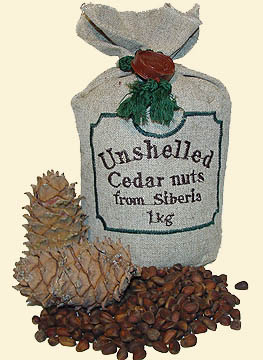 Russian folk medicine has eagerly made widespread use of Pine Nuts in the treatment of various ailments. For example, the population of Siberia has long considered Pine Nuts an effective remedy in salt deposition.
Russian folk medicine has eagerly made widespread use of Pine Nuts in the treatment of various ailments. For example, the population of Siberia has long considered Pine Nuts an effective remedy in salt deposition.
They used the nuclei of Pine Nuts in preparing alcoholates and would take daily drops of the mixture over the period of a month. The result was usually very good.
It is known that Pine Nuts were used in olden times in Yenisei Province for the treatment of abscesses. After chewing, Pine Nuts were placed on the abscess, and a bandage applied on top of the sore spot. The nuts served to soften the abscess and sped up the maturation process. After the wound was cleansed from pus, the nuts accelerated the healing.
Earlier the husk and powder of the Pine Nuts were used to prepare cleansing baths; particles of bran were also added. The bath had a most beneficial effect on the skin, especially chapped or coarsened skin. These baths were recommended in the case of diathesis, eczema, pyodermatosis and other skin diseases. In addition, a bath with the addition of a concoction made of cedar nut husks and powder has a calming action on the nervous system. It is effective in cases of overexcitement as well as overexhaustion.
A potion made with whole Pine Nuts was used for treatment of rheumatoid arthritis and gout, as well as in metabolism disorders and vitamin deficiency. They would pour vodka on ground nuts together with their shells. After letting it steep for 7 days, they would filter it and ingest over a period of 1.5-2 months.
The shell of the cedar nut is rich in tannic substances. It was used to make potions and concoctions (2-3 tablespoons per glassful), which were used in treating inflammation of the mucous membranes in the oral cavity and other organs in the form of embrocations and ablutions - in the case of skin diseases (lichen, pyodermatosis, eczema etc.), as well as burn damage.
Potions made from shells of Pine Nuts were used for the treatment of the gastro-intestinal tract. It raises the tonicity, imparts strength and resotres the normal functioning of the gastro-intestinal tract.
Potions made from shells in vodka were also used to treat hearing disorders.
A concoction of cedar nut shells could be drunk in the case of gastro-intestinal disorders. It had a cohesive, anaesthetic and anti-inflammatory action. Siberian wizards recommended using a potion made from cedar nut shells in the case of hemorrhoids. Folk medicine recommended that a potion of cedar nut shells be drunk in the case of osteochondrosis or arthritis.
A potion of cedar nut nuclei in light wine was taken as a blood-cleansing remedy. It was good to add honey to this potion too.
Folk medicine recommended a potion of cedar nut nuclei in wine with low alcoholic content be taken for bladder problems, as well as for stones in the liver and gall bladder.
The ground nuclei of Pine Nuts with honey was useful in treating ulcers. Folk medicine held that with a variety of skin diseases, including skin cancer, eczema and boils, the constant use of natural Pine Nuts or cedar oil would lead to recovery.
Pine Nuts should be a constant part of the diet of children and teenagers. They have a beneficial effect on children's physical and mental development. They are very useful and essential during the exfoliation period.
The use of Pine Nuts serves to strengthen the organism's defence mechanisms.
Cedar - here referring to the Siberian pine.
Presented by "Open Mind" organisation, Ukraine, June 25, 2005.
http://www.pinenutoil.org/
Used by permission.
© Copyright CedarInfo.info





